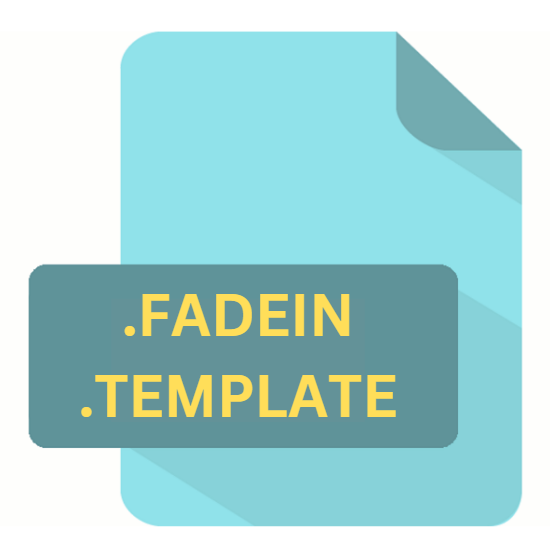.FADEIN.TEMPLATE File Extension

Fade In Template
| Developer | Kent Tessman |
| Popularity | |
| Category | Text Files |
| Format | .FADEIN.TEMPLATE |
| Cross Platform | Update Soon |
What is an FADEIN.TEMPLATE file?
The .FADEIN.TEMPLATE file extension is associated with Fade In, a popular screenwriting software designed for professionals and amateurs alike.
Fade In is known for its clean, user-friendly interface and robust feature set tailored to the needs of scriptwriters. The .FADEIN.TEMPLATE file specifically represents a template file used within the Fade In software.
Templates serve as starting points for creating new screenplays or scripts, ensuring that users adhere to industry-standard formatting and structure.
More Information.
The initial release of Fade In was well-received for its intuitive design and compatibility with various script formats. The .FADEIN.TEMPLATE file extension was introduced as part of Fade In’s efforts to support customizable templates.
These templates were designed to help writers quickly set up scripts according to various formats, including screenplays, television scripts, and stage plays.
Templates within Fade In allow users to start with predefined settings, reducing the time spent on formatting and ensuring consistency across different projects.
Over time, Fade In has continued to evolve, with updates improving the functionality of templates and expanding the types of templates available to users.
Origin Of This File.
The .FADEIN.TEMPLATE file extension originates from Fade In Professional Screenwriting Software, which was developed by Kyle Cooper and first released in 2008.
Fade In was introduced as a competitor to other scriptwriting software like Final Draft and Celtx, with a focus on providing a more flexible and affordable solution.
The inclusion of .FADEIN.TEMPLATE files reflects the software’s commitment to providing users with tools that streamline the screenwriting process.
File Structure Technical Specification.
The .FADEIN.TEMPLATE file is essentially a structured text file containing predefined script elements and formatting rules. These templates include:
- Header Information: This may include title pages, author names, and other metadata relevant to the script.
- Formatting Guidelines: Specifications for scene headings, dialogue, character names, and other elements in the script. This ensures that the script adheres to industry standards.
- Customizable Elements: Placeholder text and sections that users can fill in or modify according to their needs.
In terms of technical specification, .FADEIN.TEMPLATE files are XML-based, which allows them to be easily read and edited by the Fade In software. The XML structure facilitates the definition of various script elements and formatting rules.
How to Convert the File?
Converting a .FADEIN.TEMPLATE file to another format is not always straightforward due to its specific use within the Fade In software. Users can take the following steps:
- Export as Script: Open the .FADEIN.TEMPLATE file in Fade In, then create a new script using the template. Once the script is created, you can export it to various formats such as PDF, Final Draft (.fdx), or plain text (.txt).
- Manual Conversion: If you need to convert the template file itself, you might need to manually recreate the template in another software that supports custom templates. This process involves copying the formatting rules and structure from the .FADEIN.TEMPLATE file into the new software.
- Third-Party Tools: Some third-party tools and services may offer conversion options for different screenwriting formats. However, compatibility and accuracy can vary, so it’s essential to verify the results.
Advantages And Disadvantages.
Advantages:
- Standardization: Templates ensure that scripts adhere to industry standards, which is crucial for professional screenwriters and script submissions.
- Efficiency: By starting with a template, users save time on formatting and setup, allowing them to focus more on the creative aspects of writing.
- Customization: Users can create and modify templates to suit their specific needs, providing flexibility in how scripts are structured.
Disadvantages:
- Limited Flexibility: While templates are useful, they may impose certain formatting constraints that could limit creative freedom in some cases.
- Compatibility Issues: .FADEIN.TEMPLATE files are specific to the Fade In software. Users working with other screenwriting programs may encounter compatibility issues when trying to use these templates.
- Learning Curve: For new users, there may be a learning curve associated with understanding how to effectively use and customize templates within Fade In.
How to Open FADEIN.TEMPLATE?
Open In Windows
- Install Fade In software on your Windows PC. Once installed, open the Fade In application, then navigate to “File” > “Open” and select the .FADEIN.TEMPLATE file to use it.
Open In Linux
- Fade In is not natively supported on Linux. However, users can try running Fade In through compatibility layers like Wine or use virtual machines to run Windows applications. After setting up, you can open the .FADEIN.TEMPLATE file as described for Windows.
Open In MAC
- Install Fade In on your Mac computer. Open the Fade In application, go to “File” > “Open,” and choose the .FADEIN.TEMPLATE file to access and use it.













